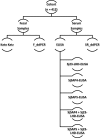Comparison of Kato Katz, antibody-based ELISA and droplet digital PCR diagnosis of schistosomiasis japonica: Lessons learnt from a setting of low infection intensity
- PMID: 30830925
- PMCID: PMC6417743
- DOI: 10.1371/journal.pntd.0007228
Comparison of Kato Katz, antibody-based ELISA and droplet digital PCR diagnosis of schistosomiasis japonica: Lessons learnt from a setting of low infection intensity
Abstract
Background: Zoonotic schistosomiasis in Asia, caused by Schistosoma japonicum, remains a major public health concern in China and the Philippines. The developing epidemiological and socio-economic picture of the disease in endemic areas necessitates the development of affordable and highly accurate field diagnostics as an important component in evaluating ongoing integrated control and elimination efforts.
Methods: Three diagnostic methods, namely Kato-Katz (KK) stool microscopy, ELISA and droplet digital (dd) PCR assays, were compared by detecting infection in a total of 412 participants from an area moderately endemic for schistosomiasis in the Philippines.
Results: This comprehensive comparison further defined the diagnostic performance and features for each assay. Compared with the ddPCR assay analysing DNA from faeces (F_ddPCR), which exhibited the highest sensitivity, the SjSAP4 + Sj23-LHD-ELISA had the best accuracy (67.2%) among all five ELISA assays assessed. Schistosomiasis prevalence determined by the SjSAP4 + Sj23-LHD-ELISA and ddPCRs was similar and was at least 2.5 times higher than obtained with the KK method. However, the agreement between these assays was low. In terms of cost and logistical convenience, the SjSAP4 + Sj23-LHD-ELISA represents a cost-effective assay with considerable diagnostic merits. In contrast, although the ddPCR assays exhibited a high level of diagnostic performance, the high cost and the need for specialized equipment presents a major obstacle in their application in screening campaigns.
Conclusion: The SjSAP4 + Sj23-LHD-ELISA represents a cost-effective tool for the diagnosis of schistosomiasis that could prove an important component in the monitoring of integrated control measures as elimination draws closer, whereas the ddPCR assays, in addition to their high sensitivity and specificity, are capable of quantifying infection intensity. However, the high cost of ddPCR hinders its wider application in screening programs, although it could be a valuable reference in the development and improvement of other diagnostic assays.
Conflict of interest statement
The authors have declared that no competing interests exist.
Figures



References
-
- Olveda RM, Tallo V, Olveda DU, Inobaya MT, Chau TN, Ross AG. National survey data for zoonotic schistosomiasis in the Philippines grossly underestimates the true burden of disease within endemic zones: implications for future control. Int J Infect Dis. 2016;45:13–7. 10.1016/j.ijid.2016.01.011 - DOI - PubMed
Publication types
MeSH terms
Substances
LinkOut - more resources
Full Text Sources

